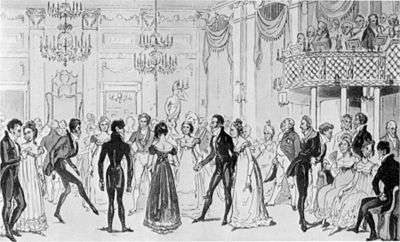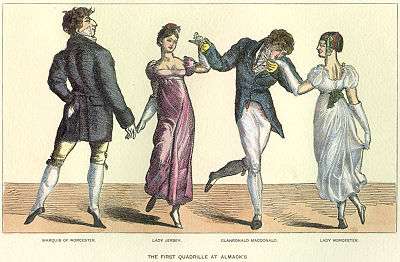Almack's

Almack's Assembly Rooms was a social club in London from 1765 to 1871 and one of the first to admit both men and women. It was one of a limited number of upper class mixed-sex public social venues in the British capital in an era when the most important venues for the hectic social season were the grand houses of the aristocracy. From 1871 it was renamed "Willis's Rooms" (see below).
History
Almack's opened on King Street, St. James, in London, on 20 February 1765.
Traditionally, it is said to have been established by William Almack, born William Macall who, to avoid the onus of a Scottish name, then considered foreign and uncouth, reversed the syllables. However, Chancellor points out that Almack is as legitimate and common a name as Macall, and may easily have been the man's actual family name.[1] His Almack's Coffee House, opened at the same time, was bought in 1774 and became the gentlemen's club, Brooks's.
The Assembly Rooms first opened in purposeful rivalry to Mrs. Cornelys' entertainments at Carlisle House; her masquerade balls were becoming notorious. At first it was described as a "female Brook's"—a gambling club to which women were admitted, as well as men. Male members proposed and elected the female members, and women proposed and elected the male members. At this time, like Almack's other establishments, it was meant to make money as what would now be called a casino. It was, like a male club, open any night, and gambling was all that went on, besides a little supper served by Mr. and Mrs. Almack, the latter of whom poured tea while wearing a fashionable sack gown.
In 1770, Horace Walpole wrote of "The Female Coterie",[2] "There is a new Institution that begins to make, and if it proceeds will make, considerable noise. It is a club of both sexes to be erected at Almack's, on the model of that of the men at White's. Mrs Fitzroy, Lady Pembroke, Mrs Meynell, Lady Molyneux, Miss Pelham and Miss Lloyd are the foundresses. I am ashamed to say I am of so young and fashionable society; but as they are people I live with, I choose to be idle rather than morose. I can go to a young supper without forgetting how much sand is run out of the hour-glass."[3]
This first phase of Almack's suffered from competition from The Pantheon or "Winter Ranelagh Gardens" from 1772 until it burned down twenty years later.[4] Play seems to have fallen off, as Almack's entered its second phase some time after 1800.
The classic Almack's
People came to Almack's to see and be seen, to assert their claim to being of the highest social rank, and to network with others of the caste. Secondarily, for gentlemen seeking brides of suitable ton, it served as one of the marriage marts of Society. By 1790, being a debutante, one presented at court, carried very little weight, as the King's court was considered rather fusty. Instead, mothers sought éclat for a daughter newly presented to society by wrangling vouchers at Almack's.[5]
Patronesses and admission
Almack's came to be governed by a select committee of the most influential and exclusive ladies of London's high society (the ton), referred to as the Lady Patronesses of Almack's. There were six or seven Patronesses at any one time.
In 1814, during the Regency of George IV, they were

- Amelia Stewart, Viscountess Castlereagh
- Sarah Villiers, Countess of Jersey, who should not be confused with her mother-in-law, Frances Villiers, Countess of Jersey, one of the more notorious mistresses of George IV when he was Prince of Wales
- Emily Lamb, Countess Cowper, sister of the Prime Minister Lord Melbourne, and later married to another Prime Minister, Lord Palmerston
- Maria Molyneux, Countess of Sefton, wife of William Molyneux, 2nd Earl of Sefton
- The Hon. Sarah Clementina Drummond-Burrell, known as Clementina, later Lady Willoughby de Eresby. Clementina was the only surviving child of James Drummond, 1st Baron Perth. On marriage, her husband Peter Burrell, a noted dandy, assumed the family name Drummond. He succeeded his father as 2nd Baron Gwydyr and subsequently his mother as 22nd Baron Willoughby de Eresby.[6]
- Dorothea Lieven, Countess de Lieven, wife of the Russian ambassador and a political force in her own right; Princess Lieven after 1826
- Countess Esterházy, wife of the Austrian ambassador Prince Paul Anton Esterházy; Princess Esterházy after 1833.[7]
These "fair arbiters" created a temple of exclusivity for the balls held on Wednesday nights (the only activity of the club) by allowing only those whom they approved to buy the non-transferrable annual "vouchers," costing ten guineas. Holding a voucher became the difference between society and Society. Not to have a voucher might mean simply that one had not applied, but to lose one's voucher meant that one had been tried and found wanting, a social disaster for those dedicated to their position in the ton. When Lady Caroline Lamb satirised Lady Jersey in her novel Glenarvon, Lady Jersey took her revenge by barring Caroline from Almack's — the ultimate social disgrace (although Lady Cowper, who was Caroline's sister-in-law, eventually got the ban lifted). No exceptions to the strict rules were ever made: the Duke of Wellington was once refused entry for being improperly dressed, and meekly complied.
The Lady Patronesses met every Monday night during the London social season (approximately April to August) to decide who, if anyone, might need to be removed for recent déclassé behavior, and whom they might wish to add to the august membership. Their reign lasted until about 1824 when exclusivity and strictness of rules both declined.
Money was not a key to being a member of Almack's, which existed to exclude the nouveau riche. Possession of a noble title was a recommendation, though breeding and behavior were more important. Even a duke or duchess might find themselves barred, if one or other of the patronesses disliked them Only about three-quarters of the hereditary nobility were admitted; however Thomas Moore, a penniless Irish poet, was a member.[5]
Dances and refreshment

To avoid any suggestion of impropriety, dances were limited to country dances, more like reels than minuets. This changed some time after the declaration of the Regency, when first the quadrille and then the waltz, at that time more like the modern polka, were introduced. According to Raikes, these were first danced at Almack's in 1813, to Gronow in 1815, and to Dancing in the Badminton Library, 1816. The introduction of the quadrille is strongly associated with Lady Jersey, and the waltz definitely linked to Countess de Lieven.[8]
The club took pains not to resemble expensive private balls by avoiding sumptuous repasts. Refreshments in the supper rooms consisted of thinly-sliced bread (which must be a day old to be sliced that thinly) with fresh butter, and dry cake (dry meaning unfrosted, without icing, not stale), probably similar to pound cake. To avoid drunkenness, only tea and lemonade were served in the supper rooms.[5]
The physical building

The original building was constructed in the Palladian style, and located on the south side of King Street. One Life in London print depicting the ballroom, c. 1821, shows tall arch-topped windows with simple draperies, with panels between of delicate decoration in the style of Robert Adam.[9] A Cruikshank print shows a different crystal chandelier, a carpeted floor, and the walls hung with gigantic mirrors and paintings.[10]

Besides the dancing rooms and the supper rooms, some historians say the later Almack's also provided gaming rooms for those who preferred cards to dancing.
In 1871, the new owner of the Assembly Rooms renamed them after himself as Willis's Rooms. They were damaged (during World War II bombing of London) in 1940 and were completely destroyed in 1944. The site is now occupied by an office building (Almack House) bearing a brass plaque commemorating the existence of Almack's on that spot.
In fiction
Almack's, in its heyday, might appear or be mentioned in any of the "silver fork novels" of the time. These notably included Almack's by Marianne Spencer Hudson (1827) and Almack's Revisited by Charles White (1828).
Almack's and its patronesses also appear frequently in the Regency romances of Georgette Heyer and many other authors of the genre. Heyer stresses the crucial importance of gaining admission to the club: "the right of entry (to Almack's) conferred on the recipient a greater distinction than a Court presentation, and was far more difficult to obtain". Despite the fact that the actual entertainment was notoriously dull and the refreshments inferior, exclusion from Almack's was the ultimate social failure.
In a significant speech made at a banquet for the London 'Metropolitan Sanitary Association' on May 10th 1851, a speech which prefigured the publication of Bleak House in serial form in March 1852, Charles Dickens referred to Almack's: 'That no man could estimate the amount of mischief grown in dirt - that no man could say the evil stops here or stops there, either to its moral or physical effects, or could deny that it begins in the cradle or was not at rest in the grave - was as certain as it was, that the air from Gin-Lane would not be carried by an easterly wind into May-fair, or that the furious pestilence raging in St Giles's, no mortal list of lady patronesses could keep out of Almack's.'[11] On early manuscripts for Bleak House the title was given as Bleak House and the East Wind.[12]
See also
Notes
- ↑ Chancellor, p.235: "It is generally believed that his original name was Macall and that he changed it, by a process of inversion, to Almack, when he first started as club proprietor, on account of the odium into which anything Scottish had fallen at this period (about the middle) of the eighteenth century. But this is based a good deal on conjecture, and in Notes and Queries a number of letters and other communications on the subject leave the matter not much clearer than it was before. ... Personally I am inclined to think that no such change was ever attempted. Almack is as common a name as Macall, although neither is frequently met with; and surely if a man had wanted to hide his origin he could have done so more skilfully and more successfully than by merely playing a conjuring trick with the letters of his name."
- ↑ Rubenhold, Hallie (2008). Lady Worsley's Whim. London: Vintage Books. pp. 175–176a.
- ↑ Chancellor, p. 205-6
- ↑ Chancellor, p. 206-7
- 1 2 3 Moers
- ↑ "Regency Personalities Series: Sarah Clementina Drummond-Burrell, A patroness of Almack's," from D.W. Wilkin's blog on goodreads. Accessed 25 January 2014.
- ↑ Patronesses list from Jehanne Wake, Sisters of Fortune (London: Chatto & Windus), p. 99.
- 1 2 Chancellor, p.212
- ↑ Margetson
- ↑ Chancellor
- ↑ Daily News (London, England), Monday, May 12, 1851; Issue 1549
- ↑ Dickens and the Broken Scripture, Janet L Lasrson, University of Georgia Press, 2008, p334.
References
| Wikimedia Commons has media related to Almack's. |
| Wikisource has the text of the 1911 Encyclopædia Britannica article Almack's. |
- Almack's at Britain Express
- Chancellor, E. Beresford. Memorials of St James's Street together with the Annals of Almack's. London, 1922.
- Hibbert, Christopher. London, the Biography of a City. New York: William Morrow, 1969.
- Margetson, Stella. Regency London. New York: Praeger Publishers, Inc., 1971.
- Moers, Ellen. The Dandy: Brummell to Beerbohm. New York: The Viking Press, Inc., 1960.
- James Paine, Orchestra leader at Almack's